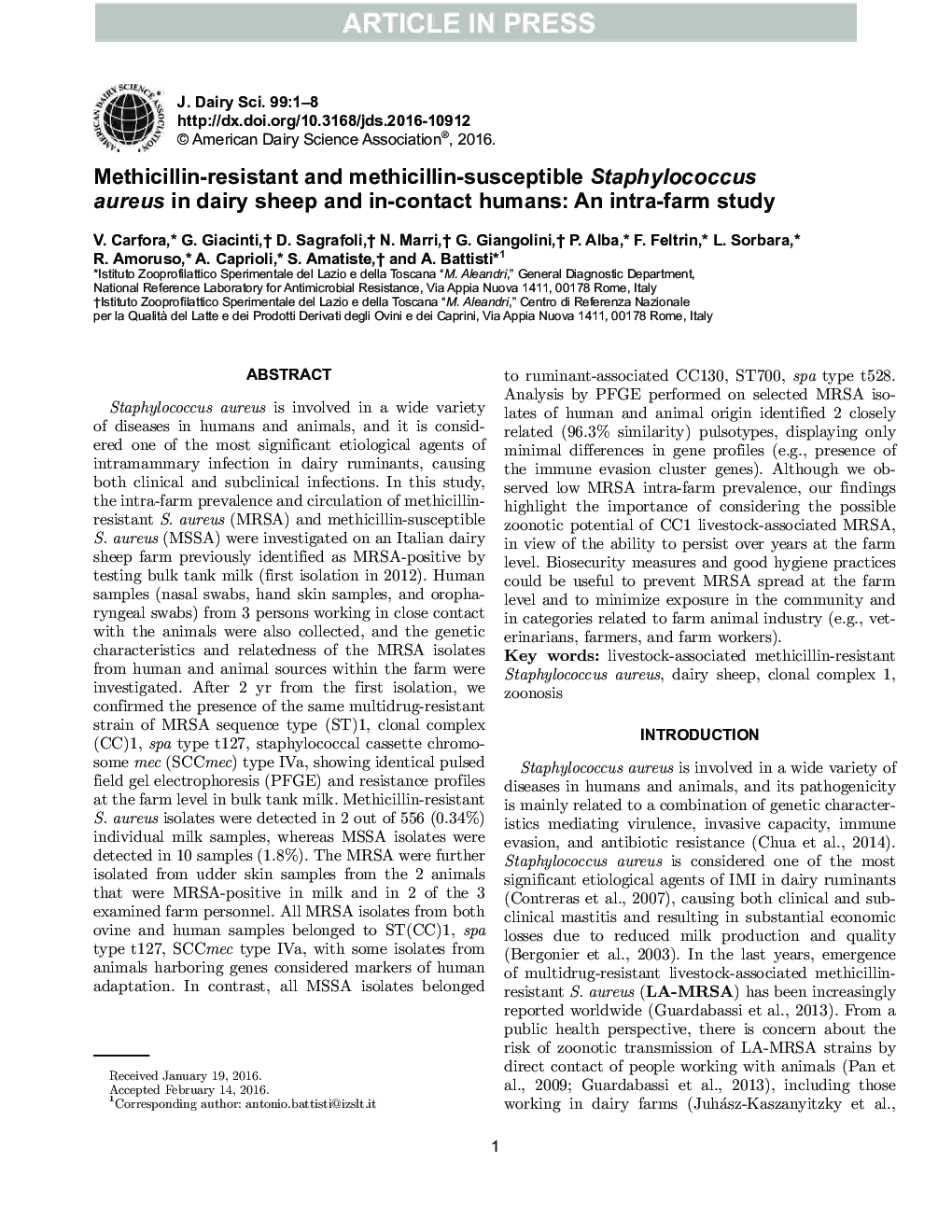| کد مقاله | کد نشریه | سال انتشار | مقاله انگلیسی | نسخه تمام متن |
|---|---|---|---|---|
| 10973292 | 1108013 | 2016 | 8 صفحه PDF | دانلود رایگان |
عنوان انگلیسی مقاله ISI
Methicillin-resistant and methicillin-susceptible Staphylococcus aureus in dairy sheep and in-contact humans: An intra-farm study
ترجمه فارسی عنوان
استافیلوکوکوس اورئوس حساس به متیسیلین و متی سیلین در گوسفندان و در تماس با انسان: یک مطالعه درون مزرعه
دانلود مقاله + سفارش ترجمه
دانلود مقاله ISI انگلیسی
رایگان برای ایرانیان
کلمات کلیدی
استافیلوکوک اورئوس مقاوم به متسییلین مرتبط با دام، گوسفند لبنی کلونال پیچیده 1، زونوز
موضوعات مرتبط
علوم زیستی و بیوفناوری
علوم کشاورزی و بیولوژیک
علوم دامی و جانورشناسی
چکیده انگلیسی
Staphylococcus aureus is involved in a wide variety of diseases in humans and animals, and it is considered one of the most significant etiological agents of intramammary infection in dairy ruminants, causing both clinical and subclinical infections. In this study, the intra-farm prevalence and circulation of methicillin-resistant S. aureus (MRSA) and methicillin-susceptible S. aureus (MSSA) were investigated on an Italian dairy sheep farm previously identified as MRSA-positive by testing bulk tank milk (first isolation in 2012). Human samples (nasal swabs, hand skin samples, and oropharyngeal swabs) from 3 persons working in close contact with the animals were also collected, and the genetic characteristics and relatedness of the MRSA isolates from human and animal sources within the farm were investigated. After 2Â yr from the first isolation, we confirmed the presence of the same multidrug-resistant strain of MRSA sequence type (ST)1, clonal complex (CC)1, spa type t127, staphylococcal cassette chromosome mec (SCCmec) type IVa, showing identical pulsed field gel electrophoresis (PFGE) and resistance profiles at the farm level in bulk tank milk. Methicillin-resistant S. aureus isolates were detected in 2 out of 556 (0.34%) individual milk samples, whereas MSSA isolates were detected in 10 samples (1.8%). The MRSA were further isolated from udder skin samples from the 2 animals that were MRSA-positive in milk and in 2 of the 3 examined farm personnel. All MRSA isolates from both ovine and human samples belonged to ST(CC)1, spa type t127, SCCmec type IVa, with some isolates from animals harboring genes considered markers of human adaptation. In contrast, all MSSA isolates belonged to ruminant-associated CC130, ST700, spa type t528. Analysis by PFGE performed on selected MRSA isolates of human and animal origin identified 2 closely related (96.3% similarity) pulsotypes, displaying only minimal differences in gene profiles (e.g., presence of the immune evasion cluster genes). Although we observed low MRSA intra-farm prevalence, our findings highlight the importance of considering the possible zoonotic potential of CC1 livestock-associated MRSA, in view of the ability to persist over years at the farm level. Biosecurity measures and good hygiene practices could be useful to prevent MRSA spread at the farm level and to minimize exposure in the community and in categories related to farm animal industry (e.g., veterinarians, farmers, and farm workers).
ناشر
Database: Elsevier - ScienceDirect (ساینس دایرکت)
Journal: Journal of Dairy Science - Volume 99, Issue 6, June 2016, Pages 4251-4258
Journal: Journal of Dairy Science - Volume 99, Issue 6, June 2016, Pages 4251-4258
نویسندگان
V. Carfora, G. Giacinti, D. Sagrafoli, N. Marri, G. Giangolini, P. Alba, F. Feltrin, L. Sorbara, R. Amoruso, A. Caprioli, S. Amatiste, A. Battisti,
